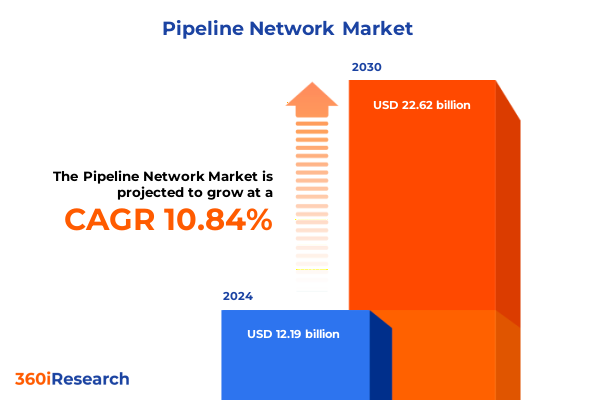The Pipeline Network Market size was estimated at USD 12.19 billion in 2024 and expected to reach USD 13.55 billion in 2025, at a CAGR 10.84% to reach USD 22.62 billion by 2030.

Introduction to the Evolving Pipeline Network Landscape
In today's rapidly advancing industrial milieu, the pipeline network market is undergoing a significant transformation. This report provides a detailed narrative that captures the technological, operational, and strategic changes that are shaping the industry. The evolving landscape is driven by innovation in infrastructure technology and increased demand for efficient, sustainable, and secure flow of resources. Industry stakeholders are increasingly acknowledging the critical importance of pipeline infrastructure as a backbone for economic growth and development.
The report offers a comprehensive overview of market dynamics, addressing both macro-level trends and micro-level technical insights. In discussing recent technological advancements, regulatory influences, and emerging best practices, the narrative underscores the necessity of continuous investment and strategic realignment. Overall, this introduction lays the groundwork for a deeper exploration of segmentation, regional factors, and the company-level innovations that collectively redefine market parameters. By aligning with current trends and anticipating future shifts, this analysis assists experts and decision-makers in navigating a rapidly changing business environment while ensuring operational resilience and competitive advantage.
Transformative Shifts in the Pipeline Network Landscape
Over the past few years, the pipeline network market has experienced transformative shifts that have redefined traditional business models and operational frameworks. These shifts are largely characterized by enhanced technological integration, refined operational strategies, and heightened regulatory compliance which together have led to a more agile and responsive market environment.
Advances in materials technology and infrastructure engineering have paved the way for the adoption of innovative pipeline materials and coatings that enhance durability and safety. Market participants are now investing in digital monitoring systems to optimize performance and reduce downtime. Moreover, the evolution of global supply chains alongside improved leak detection and maintenance methods has further spurred investments in state-of-the-art installation and management services.
Strategic partnerships and technological collaborations have also played a critical role in driving these changes. Decisions are increasingly being informed by real-time data analytics and predictive maintenance, ensuring operations remain both efficient and environmentally sustainable. This convergence of digital technology with traditional pipeline operations represents a paradigm shift, enabling companies to anticipate and mitigate risks more effectively while capitalizing on emerging opportunities valued by both regulators and end-users. The transformation witnessed is not just incremental but a wholesale reimagining of how pipeline networks will operate in a decade or more.
Key Segmentation Insights for Enhanced Market Analysis
A granular breakdown of the pipeline network market reveals several critical segmentation insights that are crucial for understanding market dynamics. One key segmentation revolves around pipeline material types, which includes an extensive study of concrete pipelines, plastic pipelines, and steel pipelines. Specifically, within the plastic pipeline category, the analysis further distinguishes cross-linked polyethylene (PEX), polyethylene (PE), and polyvinyl chloride (PVC) to provide a more refined view of material performance. In addition, segmentation based on application areas explores industry sectors such as chemical processing, the multifaceted oil and gas industry—with subdivisions including downstream, midstream, and upstream operations—and water and wastewater management where industrial water treatment and public utility management are prominent.
Further segmentation insights relate to pipeline coating types. The research delves into metallic coatings with an emphasis on galvanizing, thermoplastic coatings which are subdivided into fusion bonded epoxy and polyurethane coatings, as well as thermoset coatings. Equally important is the analysis of pipeline services that covers installation, maintenance, and the increasingly vital leak detection services. The latter is examined through the lens of both acoustic leak detection and fiber optic technologies. Additional dimensions of the study include pipeline dimensions, which differentiate between large, medium, and small diameter pipelines, and a focused evaluation of end-user industries such as mining, oil and gas, and power generation, with the power generation segment further distinguished by non-renewable and renewable sources. Lastly, the operational modes within pipeline networks, categorized into distribution and transshipment, offer insights into how logistical and operational challenges are addressed in varying market settings.
Together, these segmentation insights not only provide clarity on the technical aspects of the market but also assist stakeholders in aligning their strategic initiatives with evolving market demands. The comprehensive nature of the segmentation analysis ensures that every facet of the pipeline network is considered, enabling informed decision-making and effective resource allocation.
This comprehensive research report categorizes the Pipeline Network market into clearly defined segments, providing a detailed analysis of emerging trends and precise revenue forecasts to support strategic decision-making.
- Pipeline Material Types
- Application Areas
- Pipeline Coating Types
- Pipeline Services
- Pipeline Dimensions
- End-User Industries
- Pipeline Operation Modes
Key Regional Insights Shaping the Market
Regional dynamics have a profound impact on the development and adoption of pipeline networks. The Americas are witnessing robust infrastructural investments in modern pipeline construction and digital monitoring systems, driven by a steady demand for improved energy logistics and water management solutions. Regulatory frameworks in this region are becoming more stringent, thereby encouraging innovations that enhance safety and environmental compliance.
Across Europe, the Middle East, and Africa, market trends are largely influenced by rapid industrialization, government-driven initiatives, and evolving energy policies. This region is characterized by a blend of established and emerging markets, each emphasizing modernization of legacy systems and a gradual shift towards integrated and smart digital solutions. Meanwhile, the Asia-Pacific region stands out due to its strong economic growth, increasing urbanization, and significant investments in digital infrastructure. Countries in this zone are rapidly adopting cutting-edge technologies to streamline operations and enhance the efficiency of pipeline networks.
The interplay of these regional trends not only highlights the diversity in infrastructure maturity but also underscores the importance of tailored strategies to capitalize on specific local dynamics. Whether addressing technological disruptions or regulatory changes, the regional insights offer a rich context in which industry players can strategize their market entry and expansion plans.
This comprehensive research report examines key regions that drive the evolution of the Pipeline Network market, offering deep insights into regional trends, growth factors, and industry developments that are influencing market performance.
- Americas
- Asia-Pacific
- Europe, Middle East & Africa
Leading Companies Driving Innovation and Growth
A number of influential companies have emerged as key players in driving innovation and shaping growth in the pipeline network market. Industry leaders such as ABB Ltd., Cisco Systems, Inc., and Emerson Electric Co have consistently invested in advanced research and development to bolster their technological prowess and address complex market challenges. Firms like General Electric and Hitachi, Ltd. have set benchmarks with their integration of digital technologies into traditional pipeline operations, thereby enhancing efficiency and operational safety.
Other prominent companies, including Huawei Technologies Co., Ltd. and Moxa Inc., are redefining operational protocols through smart solutions and real-time monitoring systems. Additional innovators like Necon Group, OptaSense Ltd, and PSI Software AG are leveraging advanced analytics and sensor technologies to offer predictive maintenance services and improved leak detection strategies. Rockwell Automation, Inc., Schneider Electric, and Siemens AG have further cemented their positions by developing comprehensive solutions that integrate cutting-edge digital platforms. Moreover, companies such as Wipro Limited and Xylem Inc. continue to lead the market by combining engineering expertise with IT innovation, creating robust frameworks that underpin the growing complexity of pipeline operations.
Each company contributes uniquely to the competitive ecosystem, with a strong emphasis on sustainability, safety, and efficiency. Their concerted efforts have not only facilitated technological disruption but also driven the establishment of new industry standards. This collective momentum is pivotal in ensuring that the pipeline network continues to evolve in a manner that is both innovative and robust, ready to face emerging challenges and seize new opportunities in a dynamic global market.
This comprehensive research report delivers an in-depth overview of the principal market players in the Pipeline Network market, evaluating their market share, strategic initiatives, and competitive positioning to illuminate the factors shaping the competitive landscape.
- ABB Ltd.
- Cisco Systems, Inc.
- Emerson Electric Co
- General Electric
- Hitachi, Ltd.
- Huawei Technologies Co., Ltd.
- Moxa Inc.
- Necon Group
- OptaSense Ltd
- PSI Software AG
- Rockwell Automation, Inc.
- Schneider Electric
- Siemens AG
- Wipro Limited
- Xylem Inc.
Actionable Recommendations for Market Leaders
Industry leaders should consider several actionable strategies to bolster their competitive positioning in the pipeline network market. First, an increased focus on digital transformation can yield significant efficiencies. Investing in cutting-edge sensor technologies and data analytics tools is critical to the early detection of issues and the optimization of maintenance schedules. Next, embracing sustainable practices and eco-friendly materials is not only regulatory compliant but also aligns with the growing global emphasis on environmental stewardship.
Companies must also foster robust partnerships with technology vendors and engineering firms to integrate innovative solutions seamlessly into existing operations. Pursuing synergistic collaborations can lead to cost savings and elevate operational resilience. Additionally, market players should adopt flexible business models that allow for rapid adaptation to evolving market conditions, thereby securing a competitive edge. Continuous training and workforce upskilling further ensure that operational knowledge is kept current with technological advancements, making it easier to navigate industry disruptions and capitalize on emerging opportunities.
Explore AI-driven insights for the Pipeline Network market with ResearchAI on our online platform, providing deeper, data-backed market analysis.
Ask ResearchAI anything
World's First Innovative Al for Market Research
Conclusion: Consolidating Insights and Future Outlook
In summary, the pipeline network market is at a pivotal juncture. The report consolidates comprehensive insights across technological advancements, market segmentation, regional dynamics, and company performance. The convergence of digital transformation with traditional pipeline operations has created a landscape ripe for innovation and strategic growth, while new regulatory frameworks and environmental considerations are reshaping operational priorities.
These findings underscore a clear mandate for industry leaders: adapt swiftly, invest strategically, and foster collaborative innovation to maintain relevance in an increasingly competitive market. By balancing immediate operational needs with long-term strategic goals, companies can position themselves at the forefront of this transformative era, ensuring sustained growth and resilience in the face of evolving market challenges.
This section provides a structured overview of the report, outlining key chapters and topics covered for easy reference in our Pipeline Network market comprehensive research report.
- Preface
- Research Methodology
- Executive Summary
- Market Overview
- Market Insights
- Cumulative Impact of United States Tariffs 2025
- Pipeline Network Market, by Pipeline Material Types
- Pipeline Network Market, by Application Areas
- Pipeline Network Market, by Pipeline Coating Types
- Pipeline Network Market, by Pipeline Services
- Pipeline Network Market, by Pipeline Dimensions
- Pipeline Network Market, by End-User Industries
- Pipeline Network Market, by Pipeline Operation Modes
- Americas Pipeline Network Market
- Asia-Pacific Pipeline Network Market
- Europe, Middle East & Africa Pipeline Network Market
- Competitive Landscape
- ResearchAI
- ResearchStatistics
- ResearchContacts
- ResearchArticles
- Appendix
- List of Figures [Total: 30]
- List of Tables [Total: 634 ]
Call-To-Action: Secure Your Market Research Report Today
For a deeper dive into the intricacies of the pipeline network market, connect with Ketan Rohom (Associate Director, Sales & Marketing). Gain access to this comprehensive report that details crucial market trends, segmentation insights, and strategic recommendations. Act now to secure a report that offers authoritative analysis, actionable insights, and a clear roadmap to future success in the pipeline network industry.

- How big is the Pipeline Network Market?
- What is the Pipeline Network Market growth?
- When do I get the report?
- In what format does this report get delivered to me?
- How long has 360iResearch been around?
- What if I have a question about your reports?
- Can I share this report with my team?
- Can I use your research in my presentation?




